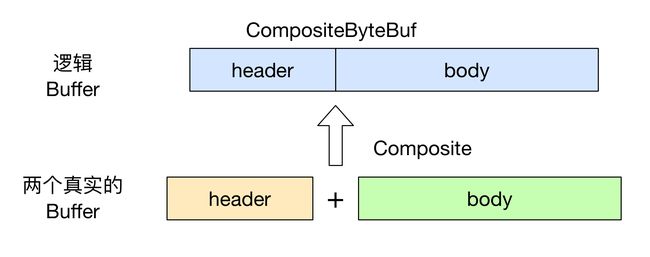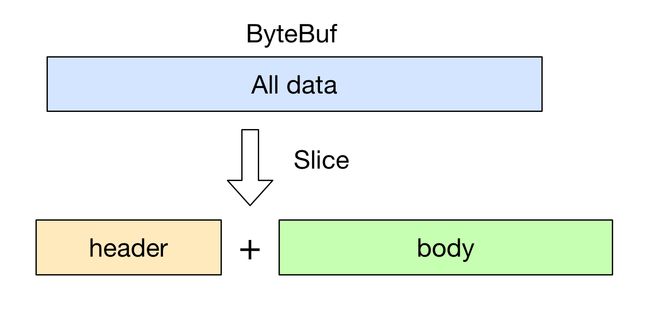Netty中的零拷贝
一.零拷贝的定义
Zero-copy, 就是在操作数据时, 不需要将数据 buffer 从一个内存区域拷贝到另一个内存区域. 因为少了一次内存的拷贝, 因此 CPU 的效率就得到的提升.
在 OS 层面上的 Zero-copy 通常指避免在 用户态(User-space) 与 内核态(Kernel-space) 之间来回拷贝数据。
但Netty 中的 Zero-copy 与 OS 的 Zero-copy 不太一样, Netty的 Zero-coyp 完全是在用户态(Java 层面)的, 它的 Zero-copy 的更多的是偏向于 优化数据操作 。
Netty的“零拷贝”主要体现以下几个方面:
1.Netty的接收和发送ByteBuffer采用DIRECT BUFFERS,使用堆外直接内存进行Socket读写,不需要进行字节缓冲区的二次拷贝。如果使用传统的堆内存(HEAP BUFFERS)进行Socket读写,JVM会将堆内存Buffer拷贝一份到直接内存中,然后才写入Socket中。相比于堆外直接内存,消息在发送过程中多了一次缓冲区的内存拷贝。
2.Netty 提供了 CompositeByteBuf 类, 它可以将多个 ByteBuf 合并为一个逻辑上的 ByteBuf, 避免了传统通过内存拷贝的方式将几个小Buffer合并成一个大的Buffer。
3.通过 FileRegion 包装的FileChannel.tranferTo方法 实现文件传输, 可以直接将文件缓冲区的数据发送到目标 Channel,避免了传统通过循环write方式导致的内存拷贝问题。
4.通过 wrap 操作, 我们可以将 byte[] 数组、ByteBuf、ByteBuffer等包装成一个 Netty ByteBuf 对象, 进而避免了拷贝操作。
二.零拷贝的具体分析
1.ByteBuffer分配Direct Buffers**
可以看我的上一篇文章Netty中关于Direct Buffers的问题思考
2.用CompositeByteBuf 类实现了将多个 ByteBuf 合并为一个逻辑上的 ByteBuf
例:
//定义两个ByteBuf类型的 body 和 header
CompositeByteBuf compositeByteBuf = Unpooled.compositeBuffer();
compositeByteBuf.addComponents(true, header, body);
分析:addComponents方法将 header 与 body 合并为一个逻辑上的 ByteBuf, 注意是通过拷贝字节数组的引用来解决问题的。而不是拷贝字节数组内容。这两个 ByteBuf 在CompositeByteBuf 内部都是单独存在的, CompositeByteBuf 只是逻辑上是一个整体。
注:
1.addComponents方法的参数是 true, 它表示当添加新的 ByteBuf 时, 自动递增 CompositeByteBuf 的 writeIndex,若没有这个参数,那么 compositeByteBuf 的 writeIndex 仍然是0, 就不可能从 compositeByteBuf 中读取到数据,
2.除了直接使用 CompositeByteBuf 类外, 还可以使用 Unpooled.wrappedBuffer 方法, 它底层封装了 CompositeByteBuf 操作,
例:ByteBuf allByteBuf = Unpooled.wrappedBuffer(header, body);
3.通过 FileRegion 实现零拷贝
3.1:使用NIO实现零拷贝
public static void copyFileWithFileChannel(String srcFileName, String destFileName) throws Exception {
RandomAccessFile srcFile = new RandomAccessFile(srcFileName, "r");
FileChannel srcFileChannel = srcFile.getChannel();
RandomAccessFile destFile = new RandomAccessFile(destFileName, "rw");
FileChannel destFileChannel = destFile.getChannel();
long position = 0;
long count = srcFileChannel.size();
srcFileChannel.transferTo(position, count, destFileChannel);
}
分析:有了 FileChannel 后, 就可以直接将源文件的内容通过transferTo)方法直接拷贝到目的文件中, 而不需要额外借助一个临时 buffer, 避免了不必要的内存操作.
3.2 :Netty官网的例子
public void channelRead0(ChannelHandlerContext ctx, String msg) throws Exception {
RandomAccessFile raf = null;
long length = -1;
try {
// 1. 通过 RandomAccessFile 打开一个文件.
raf = new RandomAccessFile(msg, "r");
length = raf.length();
} catch (Exception e) {
ctx.writeAndFlush("ERR: " + e.getClass().getSimpleName() + ": " + e.getMessage() + '\n');
return;
} finally {
if (length < 0 && raf != null) {
raf.close();
}
}
ctx.write("OK: " + raf.length() + '\n');
if (ctx.pipeline().get(SslHandler.class) == null) {
// SSL not enabled - can use zero-copy file transfer.
// 2. 调用 raf.getChannel() 获取一个 FileChannel.
// 3. 将 FileChannel 封装成一个 DefaultFileRegion
ctx.write(new DefaultFileRegion(raf.getChannel(), 0, length));
} else {
// SSL enabled - cannot use zero-copy file transfer.
ctx.write(new ChunkedFile(raf));
}
ctx.writeAndFlush("\n");
}
分析:通过 RandomAccessFile 打开一个文件, 然后 Netty 使用了 DefaultFileRegion 来封装一个 FileChannel,然后就可以直接通过它将文件的内容直接写入 Channel 中, 而不需要传统方式:拷贝文件内容到临时 buffer, 然后再将 buffer 写入 Channel.
4.通过 wrap / slice 实现零拷贝
4.1: wrap方法
ByteBuf byteBuf = Unpooled.wrappedBuffer(bytes);
分析:通过wrappedBuffer 方法来将 bytes 包装成为一个 UnpooledHeapByteBuf 对象, 而在包装的过程中, 是不会有拷贝操作的.即最后我们生成的生成的 ByteBuf 对象是和 bytes 数组共用了同一个存储空间, 对 bytes 的修改也会反映到 ByteBuf 对象中。还提供了多个重载的方法可以将一个或多个 buffer 包装为一个 ByteBuf 对象, 从而避免了拷贝操作.
4.2:slice 方法
slice 操作和 wrap 操作刚好相反, Unpooled.wrappedBuffer 可以将多个 ByteBuf 合并为一个, 而 slice 操作可以将一个 ByteBuf 切片为多个共享一个存储区域的 ByteBuf 对象.
ByteBuf header = byteBuf.slice(0, 5);ByteBuf body = byteBuf.slice(5, 10);
分析: slice 操作可以将一个 ByteBuf 切片 为多个共享一个存储区域的 ByteBuf 对象.它产生 header 和 body 的过程是没有拷贝操作的, header 和 body 对象在内部其实是共享了 byteBuf 存储空间的不同部分而已.
注:也可以设置Netty的接收Buffer为堆内存模式,有两种方法
boot.option(ChannelOption.ALLOCATOR,PooledByteBufAllocator.DEFAULT)
socketchannel.config.setAllocator(UnpooledByteBufAllocator.DEFAULT)
转载自:对于 Netty ByteBuf 的零拷贝(Zero Copy) 的理解

